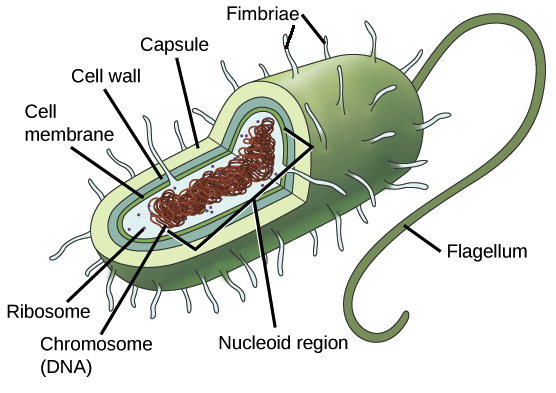DNA replication in prokaryotes and eukaryotes happens before the division of cells. Most prokaryotes have cell wall outside the plasma membrane.
What Is Linear And Circular Dna Which Type Of Dna Do Prokaryotes And Eukaryotes Have Respectively Quora
This means that they lack a nucleus mitochondria and other.

D PROKARYOTES HAVE DNA. Most prokaryotes have a cell wall outside the plasma membrane. Prokaryotes often have appendages protrusions on their surface. It depends on the sizes and details of the molecules.
Many also have a capsule or slime layer made of polysaccharide. Transcription always proceeds from the same DNA strand for each gene called the template strand. But all cells have chromosomes made up of double stranded DNA and proteins.
Because of this many prokaryotes can form biofilms like the one shown in Figure below. Most prokaryotes have a cell wall that lies outside the boundary of the plasma membrane. Prokaryotic cells are not as complex as eukaryotic cells.
Prokaryotes are unicellular organisms that lack organelles or other internal membrane-bound structures. Prokaryotes are made of cells. Most of what we know about the chromosomes of prokaryotes have been obtained from studies of Ecoli it is the organism of choice for such research of prokaryotes.
- characteristic of prokaryotic. Chromosome consists of doublestranded circular DNA. A membrane bound nucleus lmk if im right rrori130 rrori130 D is the answer.
Bacteria and Archaea differ in the compositions of their cell membranes and the characteristics of their cell walls. Unlike eukaryotes prokaryotes have no membrane-bound organelles. Some prokaryotes may have additional structures such as a capsule flagella and pili.
Plasmids are small circular DNA molecules that contain the cells nonessential genes. The correct answer is option B Prokaryotes only have one origin of replication to initiate replication. They have a single piece of circular DNA in the nucleoid area of the cell.
Borrellia species have linear chromosomes. Prokaryotes domains Archaea and Bacteria are single-celled organisms lacking a nucleus. Transcription in prokaryotes just like in eukaryotes requires the DNA double helix to partially unwind in the region of RNA synthesis the region of unwinding is called a transcription bubble.
Prokaryotes domains Archaea and Bacteria are single-celled organisms lacking a nucleus. The term prokaryotes actually means before nucleus. The capsuleprotects the cell from chemicals and from drying out.
Prokaryotic cells can also carry small molecules of DNA called plasmids. There are exceptions Deionococcus radiodurans has 4 chromosomes. Prokaryotes do not contain nucleus or other membrane bounded organelles.
Flagella and some pili are used for locomotion fimbriae help the cell stick to a surface and sex pili are used for DNA exchange. Prokaryotes have no cell nucleus and no membrane enclosed organelles. Since prokaryotes do not have a nucleus their DNA freely floats in the cytoplasm.
Most prokaryotic cells have a. It also allows the cell to stick to surfaces and to other cells. It helps in making sure that both the cells get an exact copy of the genetic material of their parents.
Prokaryotic DNA can be found in a coiled loop floating in the cytoplasm in. Prokaryotes domains Archaea and Bacteria are single-celled organisms lacking a nucleus. Most prokaryotes have a cell wall that lies outside the boundary of the plasma membrane.
Prokaryotes and eukaryotes mainly contain DNA genomes. All cells have at least one chromosome. However in eukaryotes chromosomes situate inside the nucleus.
They have a single piece of circular DNA in the nucleoid area of the cell. Some prokaryotes may have additional structures such as a capsule flagella and pili. They have a single piece of circular DNA in the nucleoid area of the cell.
Prokaryotes have single circular molecule of DNA which has only one origin of replication per circular chromosome. Prokaryotes do not have organelles with membranes. Although plasmids can occur in a variety of sizes ranging from around a thousand base pairs to hundreds of thousands they usually only have a small number of genes.
Unlike eukaryotes prokaryotes do not have. A membrane bound nucleus 2 See answers kprado05 kprado05 D. Their DNA is packaged into chromosomes.
Many prokaryotes have an extra layer called a capsule outside the cell wall. Therefore they do not have a nucleus but instead generally have a single chromosome. The most common bacteria shapes are spherical rod-shaped and.
Prokaryotic organisms have varying cell shapes. All the prokaryotes are unicellular while eukaryotes may be unicellular or multicellular organisms. They have no true nucleus as the DNA is not contained within a membrane or separated from the rest of the cell but is coiled up in a region of the cytoplasm called the nucleoid.
A piece of circular double-stranded DNA located in an area of the cell called the nucleoid. The DNA replication in prokaryotes and eukaryotes has a lot of similarities as well as differences. Prokaryotes typically have one circular chromosome made up of double stranded DNA and lots of plasmids.

Difference Between Prokaryotic And Eukaryotic Dna Definition Structure Features

Dna Packaging In Eukaryotes And Prokaryotes Biology For Majors I

Prokaryotic Cell Definition Examples Structure Biology Dictionary

47 Differences Between Prokaryotes And Eukaryotes

Dna Replication In Prokaryotes And Eukaryotes Differences Similarities

Prokaryotic Cell Definition Examples Structure Biology Dictionary

Prokaryotic Cells Article Cells Khan Academy

Structure Of Prokaryotes Boundless Biology
How Is Dna Different In Prokaryotes And Eukaryotes Quora

Prokaryote Structure Article Khan Academy

What Is The Definition Of A Prokaryotic Cells Quora

1 2 Prokaryotic Cells A Biology

Unique Characteristics Of Prokaryotic Cells Microbiology

Dna Supercoiling In Prokaryotes And Eukaryotes Bacteria And Some Download Scientific Diagram

Prokaryotic Vs Eukaryotic Dna Bioninja
Prokaryote Intracellular Structures Advanced Ck 12 Foundation
Are Prokaryotes More Complex Than Eukaryotic Cells Quora



